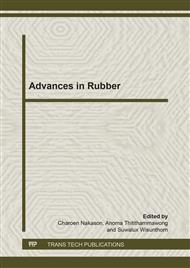p.149
p.154
p.158
p.162
p.166
p.170
p.174
p.178
p.182
Pseudolatex from STR 5L Block Rubber for Drug Delivery
Abstract:
Pseudolatex is colloidal dispersion containing spherical solid or semisolid particles and can be prepared from any existing thermoplastic water-insoluble polymers. It is useful for drug encapsulation and controlled drug release. In this study, pseudolatex base was prepared from STR 5L block rubber. The various parameters such as speed and time of homogenization, type and concentration of surfactants, amount of mineral oil, and type of drug loading were studied to prepare the stable pseudolatex. These preparations were evaluated in particle size, pH, viscosity, emulsion stability, drug encapsulation, and in vitro drug release. It was found that the most stable formulation contained 3.5% block rubber, 0.2% methyl cellulose, 6% mineral oil, 4% dibutyl phthalate, 2% sodium lauryl sulfate, and 2% Uniphen P-23 using the speed and time of homogenizer as 20000 rpm and 20 minutes, respectively. Furthermore, the pseudolatex bases reduced the protein impurity form 0.5516% to 0.2108% in formulation with mineral oil and to 0.1781% in formulation without mineral oil, that could decrease contact allergy caused by the protein allergens. Dichloromethane residues in pseudolatex bases were 22.05 mg/L and 7.85 mg/L in formulations with and without mineral oil, respectively, that were satisfied from USP recommendation value of lower than 600 mg/L. Propranolol HCl, lidocaine HCl, and indomethacin could be loaded into pseudolatex only in the concentration of 1%. However, lidocaine base in the concentration of 1-5% could be loaded into pseudolatex which had the similar physical properties and stability to pseudolatex base. The in vitro drug release from pseudolatexs provided the controlled drug release for more than 24 hr.
Info:
Periodical:
Pages:
166-169
Citation:
Online since:
November 2013
Authors:
Keywords:
Price:
Сopyright:
© 2014 Trans Tech Publications Ltd. All Rights Reserved
Share:
Citation:


